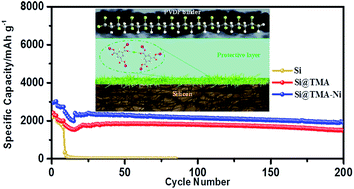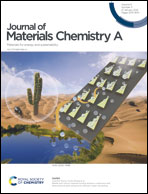Overcoming the fundamental challenge of PVDF binder use with silicon anodes with a super-molecular nano-layer†
Abstract
In the past 20 years, PVDF binders have been excluded for use with Si anodes due to their very poor electrochemical performance. To overcome this fundamental challenge, we propose a novel strategy of creating a functional buffer layer on the Si particle surface, i.e. a supramolecular layer of nickel ion-trimesic acid. The layer is able to protect Si particles and isolate Si from the PVDF chain. The applied supramolecular buffer layer not only coherently bonds with the Si core, but also promotes the formation of a stable SEI layer. As a result, an Si anode using a PVDF binder exhibits much improved initial coulombic efficiency, high rate capability and excellent cycling stability. After 200 electrochemical cycles, a reversible capacity of 1900.6 mA h g−1, corresponding to a capacity retention of 92%, is obtained, which is in sharp contrast to the almost zero capacity for a reference Si anode. The successful use of a traditional PVDF binder with an extremely high capacity Si anode provides a new avenue for the development of Si anodes for high-energy-density lithium-ion batteries.



 Please wait while we load your content...
Please wait while we load your content...